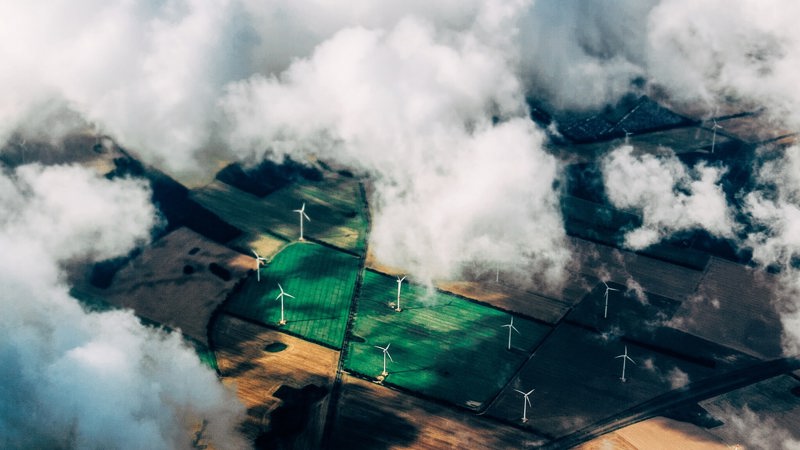
The global low carbon transition
At the end of the COP26 meeting in Glasgow last month, where nations met to discuss environmental targets and how to achieve them, a total of 151 countries had submitted new climate plans to help transition to a low carbon economy. These plans, termed ‘Nationally Determined Contributions’ (or NDCs), came with a commitment to reduce emissions by 2030. Independent monitoring organisation, Climate Action Tracker, calculates that as a result of these submitted NDC plans, as they stand, the world will be on track for 2.4˚C of warming by the end of the century. This would mean that based on these NDCs we are likely to miss the target set by the Paris Climate agreement of ‘well below 2 degrees Celsius’. Climate experts have interpreted the Paris target, assuming a 1.5 degree warming, into a requirement to slash global emissions by nearly a half by 2030 and to net-zero by 2050.
Following the International Energy Agency’s (IEA) World Energy Outlook 2021, the mentioned NDCs already include investments in renewable energy (RES-E) of about 600 GW and the ramp up of about 80 million electric vehicles by 2030. Meanwhile the IEA’s net-zero trajectories estimate a pathway where 1,100 GW of RES-E and about 160 million electric cars would be required by 2030. On a global level, despite all efforts to foster energy efficiency, a significant increase in energy demand due to economic and population growth of around 7% until 2030.
The COP26 Glasgow summit decision, therefore, calls on countries to ‘revisit and strengthen’ their 2030 targets by the end of 2022 to align them with the Paris Agreement’s temperature goals.
Energy still needs (old) infrastructure
With this context, why is there such a big difference between the ambitions expressed within the NDC plans and the required targets as defined by climate experts?
The big difference in ambitions expressed in the NDCs on the one hand and what climate experts believe to be a meaningful target for carbon reduction, on the other hand, is substantial. But this gap does not necessarily show a lack of motivation, stringent short term cost considerations or even a denial of man-made climate change – it might also simply reflect the enormous size of the practical challenges ahead. In what follows, we name a few from a European perspective:
Challenge I: Access to primary energy and bringing primary energy into Europe
Green electricity from onshore and offshore wind and solar power will be the main sources of green primary energy. It will be accompanied by biomass and hydropower - both biomass and hydro will be essential contributors but will have some limited growth potential in the long run. Some countries, for example, France and Poland, also count nuclear power as a low carbon option, while politicians in other countries, including Germany, Austria, and Italy, no longer consider nuclear power as an alternative. Similar differences between countries occur with respect to Carbon Capture and Storage (CCS) as a way to still use fossil energy carriers such as gas or coal in a close to climate-neutral way. Some countries like the Netherlands and Norway accept CCS even as a long term solution, while others see CCS only as bridging technology until enough renewable energy is accessible.
But even countries with a more flexible view on low carbon energy sources face the same problem: how can we ramp up our green electricity production quick enough in the coming decade to substitute fossil energy and cover, at the same time, increasing power demand from ongoing electrification of the economy as a consequence of more electric vehicles and heat pumps?
Historically, countries like Germany import more than 70% of their primary energy needs from other countries. Today, the European Union imports about 50% of its primary energy – most of it in the form of natural gas and oil products. Europe is, in most parts, a densely populated area with average wind and solar conditions – other regions of the world have much more favourable conditions for wind or solar power. So – as it happens today – global trade of energy products makes a lot of sense and solves the short term ramp up challenge in Europe.
From a global economy and policy perspective, it is essential to offer a long term solution(s) to oil and gas exporting countries who can then convert their domestic economy towards sustainable products. This change can happen via blue hydrogen, which is low-carbon hydrogen produced from natural gas, and sustainable fuels, for example, if Israel makes use of its gas reserves to produce hydrogen, or via green hydrogen, that is produced from renewable electricity, or green liquids in other regions with highly competitive wind and solar conditions such as the Middle East, North Africa or in Latin America.
Figure 1: Hydrogen rainbow

Source: Frontier Economics
Today, imports of green primary energy into Europe can happen via pipeline or shipping depending on the liquid or gaseous fuel and distance. However, what is clear, the importation of large quantities of electricity from far reaches will not be a viable option in most cases.
Challenge II: Transport, storage, and distribution of green energy within Europe
Wind and solar potential varies significantly by region, and the usable sites in Europe are typically in rural areas far away from the centres of energy consumption. The challenge is that new extensive energy infrastructure is difficult to build close to densely populated areas, especially in developed countries with a strong economy. This difficulty is significant for electricity, given that a typical electricity cable carries between 4 to 6 times less electricity than a hydrogen pipeline.
A further challenge is the storage requirements. A system predominantly based on volatile renewable electricity like wind or PV needs daily, weekly, and even seasonal storage – particularly for the heating sector. While we will see strong technological progress in battery development, like increased capacity and endurance, we will still need chemical storage via clean gases to store the required energy volumes – just as we do today in the form of gas storage.
Even if we could ramp up green electricity generation on time, the electricity network and storage infrastructure will not cope with such a substantial shift of the entire economy towards the electricity system if we neglect or phase out other valuable and working energy infrastructure.
Challenge III: Heavy private investments needed in end-use applications
Apart from the primary energy, transport, storage, and distribution infrastructure question, millions of end-use applications need to be adapted. In Europe, the vehicle fleet is close to 300 million passenger cars and almost 50 million trucks that would need to be transformed into electric vehicles. The vehicles are fuelled with about 93,000 petrol stations.
In Germany, the number of public charging points is about 40,000, and the number of private wall boxes is less than 300,000 units. Recent studies estimate that 15 million electric vehicles in Germany in 2030 (around one-third of the fleet) would need about 5 to 8 million private charging points - in addition to 450,000 to 850,000 public charging points. Even if all these charging points were built, there would still be around 30 million non-electric vehicles in Germany that are run with liquid fuels, requiring fuel infrastructure.
A similar challenge is true for the heating market: currently, the German heating market for residential buildings consist of 19 million heaters (for heating a total of about 42 million apartments/houses), of which 1 million are electric heat pumps. More than 75% of today’s heaters in Germany are run with natural gas or oil. Also, the direct electrification approach in the heating market would require huge investments into end-use appliances - and qualified working staff to carry this out.
Challenge IV: Regulation and reliable investment conditions
Global and local investors and infrastructure operators in gas, oil, and power infrastructure would be motivated and prepared to invest in low carbon technologies. However, the regulatory framework is not there yet. A key challenge is, therefore, for governments and regulators to draft policies and regulations that lead to reliable investment conditions, answering questions like:
- What fuel or technology counts as “green”- how can I certify my product?
- How can I enter the European market?
- What will be the “green premium”, and will it still be there in 20 years?
- How can I get access to hydrogen transport or storage infrastructure?
Many of these questions are not yet sufficiently answered by policymakers at this stage – we have a gap of clear regulation for green gases or green fuels.
Challenge V: Keeping domestic industry competitive in a global market
Another challenge high on the agenda is to defossilise* European industry while keeping the products cost-competitive on the global market. Focus is laid on subsidies (e.g. Carbon Contracts for Difference for steel industry) and on introducing a Carbon Border Adjustment Mechanism aiming at taxing imports into Europe based on their carbon content to protect European industry from competition from countries with softer environmental policies. Both instruments (and many others) are under debate but are not yet defined. What is also clear is that the costs for this will pass to citizens: subsidies will have to be paid for, and imported goods will be more expensive with the Adjustment Mechanism. This is a difficult message to be delivered to voters.
Combining new energies with old infrastructure will be the answer to fighting climate change in the medium term
Meeting our carbon abatement targets will be a huge challenge for Europe. We need to ramp up renewable electricity as quickly as possible and make use of international trade and competitive advantages in producing green gas and liquids from wind or solar power. The new green energy will need new power infrastructure. Still, we will also heavily rely on existing gas or liquid fuel infrastructure for imports, storage, transport within Europe, and energy distribution. By 2030 we will still have a significant amount of combustion engine vehicles and gas or oil fuelled heaters. The good news is that we do not have to rely only on power grids and investments in new electric end-use appliances – we can also use green molecules and green liquids both for system integration of the electric end-use appliances and decarbonise the non-electric end-use appliances. Most of the available gas or liquid fuel infrastructure and end appliances could easily be adapted to deal with hydrogen or green liquids rather than fossil natural gas or diesel. In other words, a mix of green technologies and infrastructures will be needed to address the significant challenges ahead.
For more information, visit media@frontier-economics.com or call +44 (0) 20 7031 7000.
* The molecule “C” kept in the system but made renewable and entering a circular economy.









